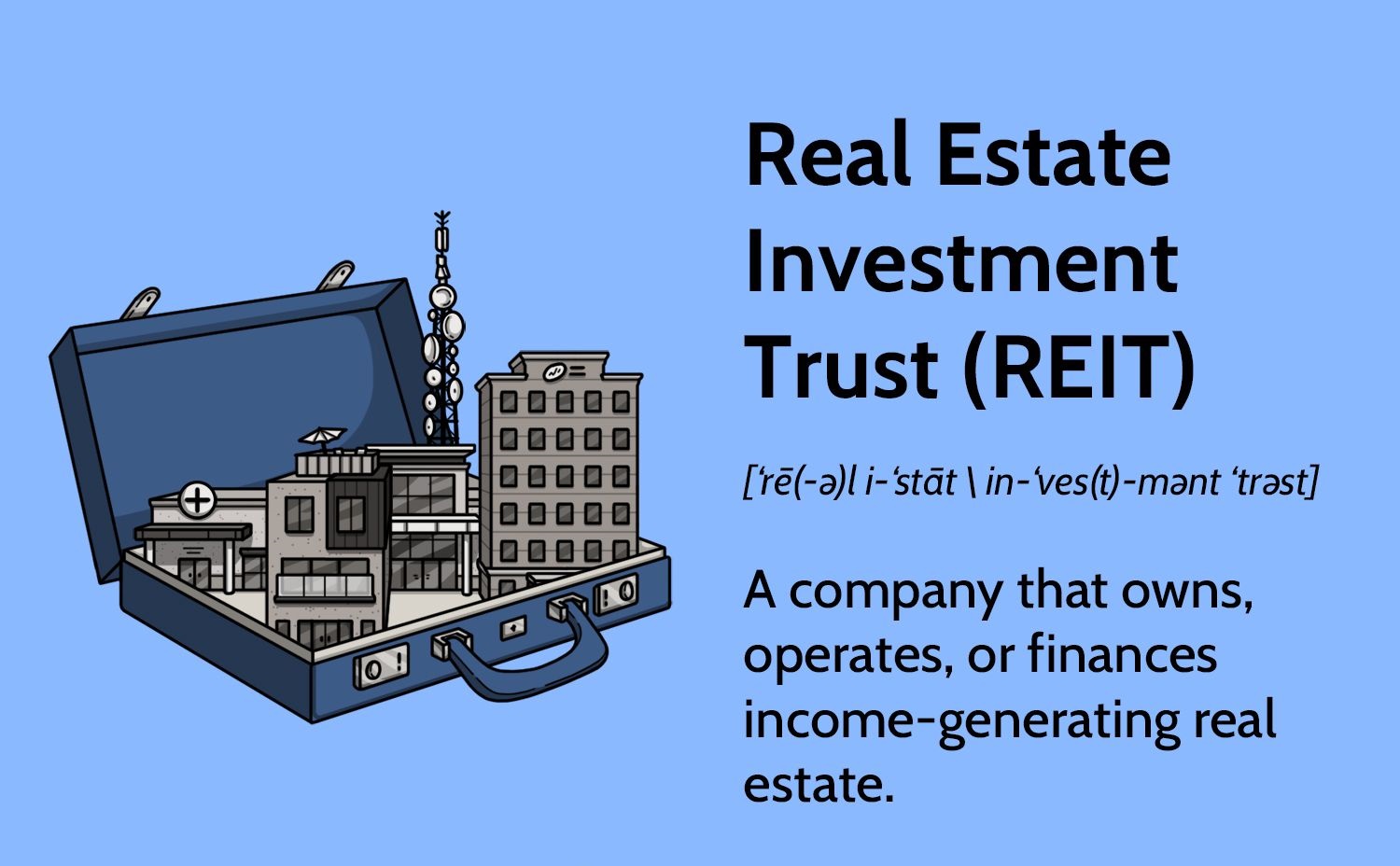Introduction
Welcome to the world of crowdfunding non-accredited REITs! If you’re looking for an innovative way to invest in real estate and want to actively participate in the growth and returns, starting your own crowdfunding non-accredited REIT might be the perfect avenue for you.
Crowdfunding has revolutionized the way individuals invest in various sectors, and real estate is no exception. Traditionally, investing in real estate required a significant amount of capital and an accredited investor status. However, with the advent of crowdfunding, the doors have been opened to non-accredited investors as well.
A crowdfunding non-accredited REIT allows you to pool capital from a diverse group of investors, enabling you to invest in a variety of real estate projects that would otherwise be out of reach. These projects can range from residential properties and commercial buildings to development projects and income-generating assets.
By starting your own crowdfunding non-accredited REIT, you become the architect of your investment strategy. You have the power to select the properties, manage the fund, and enjoy both the potential capital appreciation and regular income distributions.
In this comprehensive guide, we will walk you through the steps and requirements to start your own crowdfunding non-accredited REIT. From understanding the legal and regulatory landscape to creating a solid business plan, we’ve got you covered. So, buckle up and get ready to embark on an exciting journey that blends real estate investment with the power of crowdfunding!
What is a Crowdfunding Non-Accredited REIT?
A crowdfunding non-accredited REIT, also known as a Real Estate Investment Trust, is a unique investment vehicle that allows non-accredited investors to participate in real estate investments. Traditionally, REITs have been limited to accredited investors, who meet certain income or net worth requirements. However, crowdfunding has opened up the opportunity for non-accredited individuals to invest in real estate through REITs.
REITs themselves are entities that own, operate, or finance income-generating real estate. They pool capital from multiple investors and invest in a diversified portfolio of properties, such as residential, commercial, or industrial real estate assets. REITs distribute a large portion of their taxable income to shareholders in the form of dividends.
What sets crowdfunding non-accredited REITs apart is the ability for anyone, regardless of their income or net worth, to invest in these REITs. This democratization of real estate investment allows individuals to participate in the potential profits and benefits that come with investing in real estate, without the traditional barriers to entry.
When you invest in a crowdfunding non-accredited REIT, you become a shareholder in the REIT entity. This grants you the opportunity to benefit from the income generated by the underlying real estate properties, as well as any capital appreciation in the value of those properties.
One of the key advantages of crowdfunding non-accredited REITs is the ability to access a broader range of real estate investment opportunities. By pooling funds from a large number of investors, REITs can invest in a diversified portfolio of properties, which helps to mitigate risk and potentially enhance returns.
Furthermore, crowdfunding non-accredited REITs provide investors with a passive investment vehicle. As a shareholder, you do not have to deal with the day-to-day management of the properties. Instead, the REIT’s management team handles all operational aspects, including property acquisition, leasing, maintenance, and distributions to shareholders.
While crowdfunding non-accredited REITs offer exciting investment opportunities, it’s important to note that they are subject to specific regulatory requirements to protect investors. These requirements ensure transparency, proper disclosures, and adherence to investment guidelines. By understanding the legal and regulatory framework, you can navigate the crowdfunding landscape with confidence.
Benefits of Starting a Crowdfunding Non-Accredited REIT
Starting a crowdfunding non-accredited REIT can offer a multitude of benefits for both the investors and the REIT sponsor. Let’s explore some of the key advantages of venturing into this exciting realm of real estate investment.
1. Access to a Broader Investor Base: By creating a crowdfunding non-accredited REIT, you can attract a larger pool of potential investors. This inclusivity allows you to tap into a diverse group of individuals who may have a keen interest in real estate but may not qualify as accredited investors.
2. Diversification of Capital: As the sponsor of a crowdfunding non-accredited REIT, you have the ability to raise capital from a variety of sources. This diversification of capital not only reduces your reliance on a single investor or funding method but also allows you to explore different investment opportunities and expand your real estate portfolio.
3. Lower Barrier to Entry: Unlike traditional REITs that require investors to meet specific income or net worth thresholds, crowdfunding non-accredited REITs have a lower barrier to entry. This provides an avenue for individuals with smaller investment budgets to participate in real estate investments and potentially benefit from the returns associated with this asset class.
4. Flexibility in Investment Strategy: When you start your own crowdfunding non-accredited REIT, you have the freedom to define and execute your investment strategy. You can focus on specific types of properties or geographic locations that align with your expertise and market analysis. This flexibility allows you to tailor your portfolio to meet your investment objectives and potentially maximize returns.
5. Expertise and Support: As the sponsor of a crowdfunding non-accredited REIT, you have the opportunity to assemble a team of professionals with expertise in real estate, legal matters, compliance, and marketing. This support system can help you navigate the complexities of real estate investments and ensure you are operating in accordance with regulations, maximizing your chances of success.
6. Potential for Higher Returns: Real estate investments have the potential to generate attractive returns over the long term. By starting a crowdfunding non-accredited REIT, you can leverage the power of pooled capital to invest in a diversified portfolio of real estate assets. This diversification helps spread risk and increases the potential for higher returns compared to investing in a single property.
7. Community and Social Impact: Crowdfunding non-accredited REITs provide an opportunity to create a sense of community and social impact. With investors from various backgrounds, you can build a network of like-minded individuals who are passionate about real estate and share a common goal of generating returns while making a positive impact on communities through property investments.
Starting a crowdfunding non-accredited REIT opens up a world of possibilities for investors and sponsors alike. From broadening your investor base to enjoying the potential benefits of real estate investments, this innovative approach to fundraising can be a rewarding and fulfilling experience.
Understanding the Legal and Regulatory Requirements
Before diving into the world of crowdfunding non-accredited REITs, it’s crucial to have a solid understanding of the legal and regulatory requirements that govern this type of investment vehicle. Compliance with these requirements is vital to protect both investors and REIT sponsors, ensuring transparency, fair practices, and accountability.
1. Securities Laws and Regulations: Crowdfunding non-accredited REITs are subject to securities laws and regulations, which vary by jurisdiction. These laws typically require REITs to register their offering with the appropriate regulatory authorities and provide detailed disclosures about the investment opportunity. It’s crucial to consult with legal professionals who specialize in securities laws to ensure compliance.
2. Disclosure Requirements: Transparency is key in crowdfunding non-accredited REITs. Sponsors must provide comprehensive and accurate information to potential investors, including details about the underlying real estate properties, financial projections, management team, and any potential risks associated with the investment. Disclosures should be easily understandable and easily accessible to all investors.
3. Investor Qualifications: While crowdfunding non-accredited REITs allow non-accredited investors to participate, there may still be certain qualifications in place. These can include age restrictions, residency requirements, or limitations on the amount an individual can invest. It’s essential to have a clear understanding of these qualifications to ensure compliance and avoid any legal issues.
4. Anti-Money Laundering (AML) Regulations: To prevent money laundering and illicit financial activities, crowdfunding non-accredited REITs must adhere to AML regulations. This includes implementing robust KYC (Know Your Customer) procedures to verify the identity of investors and flag any suspicious transactions. AML compliance is crucial to maintain the integrity of the investment platform and protect against reputational and legal risks.
5. Tax Considerations: REITs have specific tax requirements and may qualify for certain tax benefits. Understanding the tax implications of starting and operating a crowdfunding non-accredited REIT is essential to ensure compliance with tax laws and maximize the financial benefits for both the REIT and its investors. Consulting with tax professionals can help navigate the complexities of tax regulations in relation to crowdfunding non-accredited REITs.
It’s important to note that regulations surrounding crowdfunding non-accredited REITs may evolve and vary based on jurisdiction. Staying updated on changes in legislation is crucial to maintain compliance and protect the interests of both the investors and the REIT sponsor.
By having a clear understanding of the legal and regulatory requirements, you can establish a strong foundation for your crowdfunding non-accredited REIT. Seeking professional advice from legal experts who specialize in securities laws and compliance will help ensure that your REIT operates within the boundaries of the law, providing investors with the necessary disclosures and protections they deserve.
Steps to Start a Crowdfunding Non-Accredited REIT
Starting a crowdfunding non-accredited REIT involves several crucial steps to ensure a successful launch and operation. Let’s explore the key steps involved in establishing your own REIT and opening the doors for non-accredited investors to participate.
1. Define Your Investment Strategy and Objectives: Before diving into the technicalities, clarify your investment strategy and objectives. Determine your target real estate sectors, geographic focus, risk tolerance, and desired returns. This will lay the foundation for your investment decisions and shape the overall direction of your crowdfunding non-accredited REIT.
2. Create a Business Plan and Financial Projections: Develop a detailed business plan that outlines your mission, vision, and strategies. Include financial projections, outlining expected costs, revenue streams, and growth projections. This helps demonstrate the feasibility of your REIT to potential investors and stakeholders.
3. Select a Qualified Legal and Compliance Team: Engage professionals who specialize in real estate law and securities regulations. A skilled legal and compliance team will help you navigate the complex web of regulations, ensuring compliance with securities laws, proper disclosures, and adherence to investor protection measures.
4. Determine the Capital Structure and Fundraising Strategy: Decide on the capital structure of your crowdfunding non-accredited REIT. Determine how much capital you need to raise and establish a comprehensive fundraising strategy. This may involve utilizing online crowdfunding platforms, traditional marketing efforts, or building relationships with potential investors.
5. Create and Register the REIT Entity: Choose a suitable legal structure, such as a corporation or a limited liability company (LLC), for your REIT. Register the entity with the appropriate regulatory authorities and ensure compliance with local laws and regulations regarding company formation and operation.
6. Implement Risk Management and Compliance Measures: Develop internal risk management processes and compliance measures to protect both your investors and your REIT. This includes conducting due diligence on potential real estate investments, implementing internal controls, and continuously monitoring and reporting on the performance of your investments.
7. Develop a Marketing and Investor Outreach Plan: Create a comprehensive marketing and investor outreach plan to attract potential investors. Utilize online and offline marketing channels, develop a compelling investment proposition, and leverage the power of social media and digital platforms to reach a wider audience of non-accredited investors.
8. Launch the Crowdfunding Campaign and Secure Investments: Once your marketing and outreach plan is in place, launch your crowdfunding campaign. Engage with potential investors, provide them with the necessary information and disclosures, and showcase the value proposition of your crowdfunding non-accredited REIT. Secure investments from interested individuals who align with your investment strategy and objectives.
9. Begin Managing the REIT’s Assets and Distributions: Once investments are secured, it’s time to begin managing the real estate assets within your REIT’s portfolio. Ensure proactive property management, timely rent collection, and efficient distribution of income to investors as per the predetermined schedule.
By following these steps, you can establish a crowdfunding non-accredited REIT and provide non-accredited investors with an opportunity to participate in real estate investments. Remember to seek professional advice and maintain compliance with legal and regulatory requirements throughout the entire process.
Define Your Investment Strategy and Objectives
Defining a clear investment strategy and objectives is the first crucial step in starting a crowdfunding non-accredited REIT. This step lays the foundation for your entire operation and helps shape the direction of your real estate investments. Here are some key considerations to help you establish a solid investment strategy:
A. Determine Real Estate Sectors: Consider which real estate sectors align with your expertise and market analysis. You may choose to focus on residential properties, commercial buildings, industrial spaces, or even niche sectors like healthcare or self-storage. Understanding the trends, demand, and potential risks in these sectors will inform your investment decisions.
B. Geographic Focus: Decide on the geographic areas where you want to invest. Are you looking to invest locally, regionally, or nationally? Consider factors such as population growth, job market trends, rental demand, and economic indicators to identify areas with potential for growth and stability.
C. Risk Tolerance: Assess your risk tolerance and determine the level of risk you are willing to take on. Different types of real estate investments come with varying degrees of risk, and it’s essential to align your investment strategy with your risk profile. For instance, investing in stable income-generating properties carries lower risk compared to investing in development projects.
D. Investment Objectives: Clearly define your investment objectives. Are you looking for long-term capital appreciation, regular income distributions, or a combination of both? Consider the time horizon of your investments and the desired annualized returns to set realistic goals for your crowdfunding non-accredited REIT.
E. Portfolio Diversification: Determine the level of diversification you want to achieve within your portfolio. Investing in a mix of different property types and locations can help mitigate risk and enhance returns. Strive for a balanced portfolio that aligns with your investment strategy while spreading risk across various assets.
F. Exit Strategy: Consider your exit strategy for each investment. Will you hold properties for the long term or aim to sell them within a specific time frame? Understanding the potential exit options, such as selling a property, refinancing, or even executing a 1031 exchange, will help you plan your investment strategy accordingly.
G. Social and Environmental Factors: Factor in any social or environmental considerations that align with your investment philosophy. For instance, you may prioritize investments that promote sustainability, energy efficiency, or community development. Considering these factors can not only generate attractive returns but also make a positive impact on society and the environment.
Remember, your investment strategy should reflect your expertise, risk tolerance, and long-term goals. Regularly reassess and fine-tune your strategy based on market conditions, investor feedback, and performance evaluation to ensure you stay on track and maximize the potential of your crowdfunding non-accredited REIT.
Create a Business Plan and Financial Projections
Creating a comprehensive business plan and financial projections is a critical step in starting a crowdfunding non-accredited REIT. It serves as a roadmap for your operations, guiding your decisions and providing a clear vision for your REIT. Here are some key elements to consider when creating your business plan:
A. Executive Summary: Start with an executive summary that provides an overview of your crowdfunding non-accredited REIT. Include a mission statement, a description of your investment strategy, and an outline of your objectives. This summary should effectively communicate the purpose of your REIT and capture the interest of potential investors.
B. Company Description: Provide a detailed description of your REIT, including its legal structure, geographic focus, and target real estate sectors. Highlight your competitive advantages, team expertise, and any unique selling points that differentiate your REIT from competitors.
C. Market Analysis: Conduct a thorough market analysis to understand the real estate landscape in your target market. Identify trends, demand-supply dynamics, and economic indicators. Pinpoint market opportunities that align with your investment strategy, and analyze potential risks that could impact your investments.
D. Investment Strategy: Clearly articulate your investment strategy, including the types of properties you plan to invest in, the acquisition process, and the criteria for selecting properties. Outline your approach to property management, risk management, and potential strategies for increasing returns.
E. Marketing and Investor Outreach: Develop a marketing and investor outreach plan to attract potential investors. Describe your approach to raising capital, including your use of crowdfunding platforms, traditional marketing channels, and personal networks. Explain how you will communicate with prospective investors and provide them with the necessary information and disclosures.
F. Financial Projections: Prepare detailed financial projections that outline the expected costs, revenue streams, and growth trajectory of your crowdfunding non-accredited REIT. Include projected cash flow, income statements, balance sheets, and break-even analysis. These projections will help investors assess the potential returns and evaluate the viability of investing in your REIT.
G. Risk Management and Compliance: Discuss your risk management strategies and compliance measures to mitigate potential risks associated with real estate investments. Address regulatory compliance, investor protection, and ongoing monitoring and reporting of investment performance. Show potential investors that you have processes in place to ensure transparency and accountability.
H. Exit Strategy: Include an exit strategy that outlines how you plan to exit investments and potentially provide liquidity to investors. Discuss different exit options, such as property sales, refinancing, or mergers. Outline the criteria for determining when to exit an investment, such as achieving target returns or capital appreciation.
Remember to regularly review and update your business plan and financial projections as market conditions change and your REIT progresses. A well-crafted business plan instills confidence in investors and provides a roadmap for success as you navigate the world of crowdfunding non-accredited REITs.
Select a Qualified Legal and Compliance Team
Selecting a qualified legal and compliance team is a crucial step in starting a crowdfunding non-accredited REIT. These professionals will help navigate the complex legal and regulatory landscape, ensuring compliance and protecting the interests of both your REIT and its investors. Here are some important considerations when choosing your legal and compliance team:
A. Real Estate Law Expertise: Look for legal professionals with expertise in real estate law. They should have a deep understanding of the specific regulations and requirements surrounding real estate investments, crowdfunding, and securities laws. Their knowledge and experience in the field will be instrumental in ensuring compliance and providing guidance throughout the establishment and operation of your REIT.
B. Securities Regulations Knowledge: Your legal team should be well-versed in securities regulations and the specific laws governing crowdfunding non-accredited REITs. They should understand the compliance measures needed to protect both investors and your REIT, such as proper disclosure requirements, investor qualification standards, and registration processes. Their expertise will help ensure that your REIT operates within the legal boundaries and meets all necessary regulatory obligations.
C. Compliance Support: Compliance is a critical aspect of running a crowdfunding non-accredited REIT. Your legal team should have a thorough understanding of compliance requirements and be able to develop and implement effective compliance programs. This includes establishing robust internal controls, conducting regular audits, and making sure all necessary filings and documentation are completed accurately and on time.
D. Reputation and Track Record: Research the reputation and track record of the legal and compliance professionals or firms you are considering. Look for professionals with extensive experience in real estate and crowdfunding, with a history of successful client engagements. Reading client reviews, checking references, and assessing their standing within the legal community can give you confidence in their abilities.
E. Clear Communication: Effective communication is crucial when working with legal and compliance professionals. Choose individuals who can clearly explain complex legal matters in a way that is easy for you to understand. They should be responsive to your questions and concerns and provide timely and comprehensive guidance.
F. Team Collaboration: Consider the ability of the legal and compliance team to collaborate effectively with other professionals involved in your crowdfunding non-accredited REIT, such as accountants, tax advisors, and property managers. Building a cohesive team that can work together harmoniously ensures a smooth operation and helps you address legal and compliance matters from a holistic perspective.
G. Proactive Approach: A proactive legal and compliance team goes beyond simply addressing your immediate needs. They anticipate potential legal issues and provide proactive solutions and guidance. Look for professionals who stay updated on changes in legal regulations and industry trends, and who offer strategic advice to help you navigate any challenges that may arise.
By carefully selecting a qualified legal and compliance team, you can ensure that your crowdfunding non-accredited REIT operates within the boundaries of the law. Their expertise and guidance will protect your interests and provide investors with the necessary confidence to participate in your REIT.
Determine the Capital Structure and Fundraising Strategy
Determining the capital structure and fundraising strategy is a critical step in starting a crowdfunding non-accredited REIT. It involves defining how much capital you need to raise, evaluating different sources of funding, and developing strategies to attract investors. Here are key considerations to help you achieve a successful capital structure and fundraising strategy:
A. Capital Requirements: Evaluate your funding needs by considering the types of real estate investments you plan to make, associated costs, and operating expenses. Determine the minimum capital required to initiate operations and ensure sufficient funds to cover ongoing expenses until the REIT becomes self-sustaining.
B. Equity vs. Debt Financing: Explore different funding options, such as equity financing and debt financing, to determine the best mix of capital for your REIT. Equity financing involves raising funds through the sale of ownership interests, while debt financing involves borrowing funds that must be repaid with interest. Consider the advantages and disadvantages of each option to strike the right balance in your capital structure.
C. Investment Partnerships: Consider forming strategic partnerships with other organizations or individuals who share similar investment goals and can contribute capital to your crowdfunding non-accredited REIT. These partnerships can provide access to additional funding sources and help distribute the financial responsibility and risk associated with real estate investments.
D. Crowdfunding Platforms: Leverage crowdfunding platforms that cater to non-accredited investors to raise capital for your REIT. Register your REIT with recognized platforms that specialize in real estate crowdfunding. These platforms provide an opportunity to reach a wide investor base and showcase your investment opportunities to potential investors who are interested in real estate but may not qualify as accredited investors.
E. Traditional Marketing Efforts: Implement traditional marketing efforts to attract potential investors. This can include organizing informational seminars, participating in real estate expos or conferences, and networking with industry professionals. Create marketing materials, such as brochures or presentations, that articulate the value proposition of your crowdfunding non-accredited REIT and effectively communicate its investment potential.
F. Building Investor Relationships: Focus on building strong relationships with potential investors. Engage with them through regular communication, provide updates on investment opportunities and performance, and address any questions or concerns they may have. By fostering trust and credibility, you can cultivate long-term relationships that lead to repeat investments and positive word-of-mouth referrals.
G. Effective Use of Technology: Embrace technology to streamline your fundraising efforts. Utilize crowdfunding platforms, online marketing channels, and social media to reach a wider audience and increase the visibility of your crowdfunding non-accredited REIT. Leverage technology to provide an easy and efficient process for potential investors to learn about your REIT, review documentation, and make investment decisions.
H. Compliance and Investor Protection: Ensure compliance with securities regulations and investor protection measures when fundraising for your crowdfunding non-accredited REIT. Provide potential investors with clear disclosures and transparent information regarding the investment opportunity, risks involved, and any limitations on liquidity. Comply with investor qualification requirements and maintain proper records to demonstrate compliance with legal obligations.
By carefully determining the capital structure and implementing an effective fundraising strategy, you can secure the necessary funds to launch and sustain your crowdfunding non-accredited REIT. Remember to stay updated on crowdfunding regulations, leverage technology, and prioritize transparency and compliance to build trust with potential investors.
Create and Register the REIT Entity
Creating and registering the REIT entity is a crucial step in the process of starting a crowdfunding non-accredited REIT. This step involves selecting the appropriate legal structure for your REIT and ensuring compliance with the necessary registration requirements. Here are the key considerations for creating and registering your REIT entity:
A. Legal Structure: Determine the legal structure that best suits your crowdfunding non-accredited REIT. Common options include forming a corporation or a limited liability company (LLC). Consult with legal professionals to understand the advantages and disadvantages of each structure and choose the one that aligns with your business objectives and compliance obligations.
B. Name and Branding: Select a name for your REIT that is unique and descriptive of its purpose. Ensure the chosen name complies with local regulations and does not infringe upon any existing trademarks. Consider securing the appropriate domain name and creating a strong brand identity to differentiate your REIT in the market.
C. Registration Process: Research the registration requirements that apply to your jurisdiction. File the necessary documents with the appropriate regulatory authorities to register your REIT entity. This typically involves providing information on the company’s directors, shareholders or members, business address, and the purpose of the REIT. Follow any additional procedures and pay the required fees to complete the registration process.
D. Regulatory Compliance: Ensure that your REIT complies with all applicable regulatory requirements. This includes adhering to securities laws, crowdfunding regulations, and any other relevant legal obligations. Maintain proper records and fulfill ongoing compliance obligations such as annual reporting, filing of financial statements, and disclosures to investors.
E. Professional Guidance: Seek guidance from legal and tax professionals who specialize in real estate and crowdfunding. They can provide valuable advice on the registration process, compliance obligations, and tax considerations. Working with professionals who have experience in the specific domains of real estate and crowdfunding ensures that your REIT is established and registered correctly.
F. Investor Protection Measures: Implement investor protection measures as part of your registration process. Provide potential investors with clear and accurate disclosures about the investment opportunity, including risk factors, potential returns, and any restrictions on liquidity. Comply with investor accreditation or qualification requirements as mandated by applicable securities laws and regulations.
G. Operating Agreements and Bylaws: Prepare appropriate operating agreements or bylaws for your REIT entity. These documents outline the governance framework, internal procedures, and decision-making processes. They set the framework for how the REIT will be managed, including the roles and responsibilities of directors, officers, and any committees involved in the operation and oversight of the REIT.
H. Intellectual Property Protection: Consider protecting your REIT’s intellectual property, such as trademarks and domain names. Registering trademarks can safeguard your brand identity and prevent others from using similar names that may cause confusion in the market. Protecting your domain name helps establish a strong online presence for your REIT.
Creating and registering the REIT entity requires careful attention to legal and regulatory requirements. By consulting with professionals and ensuring compliance, you can establish a solid foundation for your crowdfunding non-accredited REIT and operate within the boundaries of the law.
Implement Risk Management and Compliance Measures
Implementing robust risk management and compliance measures is essential when starting a crowdfunding non-accredited REIT. These measures help protect both your REIT and its investors, ensuring transparency, accountability, and adherence to legal and regulatory requirements. Here are key steps to consider when implementing risk management and compliance measures:
A. Conduct Due Diligence: Perform thorough due diligence when evaluating potential real estate investments. This includes analyzing the property’s financials, assessing market conditions, and conducting property inspections. Carefully evaluate the risks associated with each investment opportunity to make informed decisions that align with your REIT’s investment strategy and objectives.
B. Internal Control Systems: Establish internal control systems to monitor and manage risks within your REIT. Implement processes and procedures to ensure proper financial reporting, asset valuation, and compliance with regulatory requirements. Develop systems for documenting and monitoring investor relations, property management, and internal governance.
C. Compliance with Securities Laws: Adhere to securities laws and regulations specific to crowdfunding non-accredited REITs. Ensure compliance with registration, disclosure, and reporting obligations as required by the relevant regulatory authorities. Work closely with legal professionals who specialize in securities laws to navigate the complexities and mitigate any compliance risks.
D. Investor Protection: Prioritize investor protection by providing clear and accurate disclosures regarding the investment opportunity. Clearly outline the risks, potential returns, and any limitations on liquidity. Adopt transparency and good governance practices to build trust and credibility with your investors. Establish open lines of communication to address any investor concerns or queries promptly.
E. Ongoing Monitoring and Reporting: Continuously monitor the performance of your real estate investments and provide regular updates to investors. Implement robust reporting systems that accurately capture the financial performance, occupancy rates, and rental income of the properties within your REIT’s portfolio. Regularly communicate with investors, providing them with timely and comprehensive information regarding the status of their investments.
F. Data Security and Privacy: Protect sensitive investor and REIT data by implementing strict data security and privacy measures. Maintain secure systems for storing and transmitting data, and comply with applicable data protection regulations. Safeguard investor information and adopt best practices to mitigate the risk of data breaches or unauthorized access.
G. Compliance Training and Education: Ensure that your team is well-versed in risk management and compliance measures. Provide training and educational resources to employees to enhance their understanding of regulatory requirements, internal control systems, and best practices. Foster a culture of compliance within your organization to mitigate risks and promote ethical conduct.
H. Regular Compliance Audits: Conduct regular compliance audits to assess the effectiveness of your risk management and compliance measures. Engage independent auditors to review your REIT’s operations, internal controls, and compliance with legal and regulatory obligations. Address any identified deficiencies or areas for improvement to strengthen your risk management framework.
By implementing comprehensive risk management and compliance measures, you create a solid foundation for the success and sustainability of your crowdfunding non-accredited REIT. Prioritizing risk mitigation, investor protection, and compliance ensures transparency, builds investor confidence, and enhances the long-term viability of your REIT.
Develop a Marketing and Investor Outreach Plan
Developing a well-thought-out marketing and investor outreach plan is crucial when starting a crowdfunding non-accredited REIT. An effective plan will help you attract potential investors, communicate your value proposition, and build credibility. Here are key steps to consider when developing your marketing and investor outreach plan:
A. Identify Target Audience: Define your target audience. Consider demographics, investment preferences, and geographic location. Understanding your target audience will enable you to tailor your marketing messages and outreach efforts to resonate with their needs and interests.
B. Craft a Compelling Value Proposition: Clearly articulate the value proposition of your crowdfunding non-accredited REIT. Highlight the unique benefits and advantages of investing in your REIT, such as potential returns, diversification, and access to real estate opportunities typically limited to accredited investors.
C. Utilize Online Platforms: Leverage the power of online platforms to reach a wider audience. Establish a professional website that showcases your crowdfunding non-accredited REIT, its investment strategy, and key information for potential investors. Utilize social media platforms, content marketing, and search engine optimization techniques to increase your online visibility and engage with potential investors.
D. Content Marketing: Develop informative and engaging content such as blog posts, articles, and videos that provide valuable insights on real estate investment, industry trends, and the benefits of crowdfunding non-accredited REITs. Share this content on your website, social media platforms, and other relevant online channels to position yourself as a thought leader and attract potential investors.
E. Networking and Relationship Building: Attend industry events, conferences, and real estate networking groups to connect with potential investors and industry professionals. Proactively build relationships with individuals who may have an interest in real estate investment or who can provide valuable referrals to potential investors.
F. Collaborations and Partnerships: Consider collaborating with strategic partners who align with your values and have a complementary client base. This can include financial advisors, real estate brokers, or other professionals who have access to potential investors. Partnering with trusted individuals or organizations can expand your reach and enhance your credibility in the market.
G. Educational Webinars and Seminars: Organize educational webinars or seminars on real estate investment topics. Position yourself as an expert by sharing valuable knowledge, insights, and industry trends. This can help establish trust, build credibility, and attract potential investors who are looking for educational resources.
H. Referral Programs: Implement referral programs that incentivize existing investors or partners to refer new investors to your crowdfunding non-accredited REIT. Offer rewards or bonuses for successful referrals, encouraging your network to spread the word and introduce potential investors to your investment opportunities.
I. Clear Communication Channels: Provide multiple channels for potential investors to communicate with you and obtain information about your REIT. Offer clear contact information, including email, phone, and social media channels, and ensure prompt and helpful responses to inquiries. Establishing open lines of communication can strengthen investor trust and facilitate the decision-making process.
J. Compliance with Advertising Regulations: Be mindful of advertising regulations in your jurisdiction. Ensure that marketing materials and communications comply with applicable securities laws and regulations. Provide accurate and clear information about your REIT, including potential risks and limitations on liquidity.
By developing a comprehensive marketing and investor outreach plan, you can effectively communicate the value of your crowdfunding non-accredited REIT, engage with potential investors, and build a solid investor base. Leveraging online platforms, networking, and educational efforts will help you expand your reach and attract individuals interested in participating in real estate investments.
Launch the Crowdfunding Campaign and Secure Investments
Launching a crowdfunding campaign is a critical step in starting a crowdfunding non-accredited REIT. This phase involves implementing a well-planned strategy to attract potential investors and secure investments for your REIT. Here are key steps to consider when launching your crowdfunding campaign:
A. Prepare Compelling Investment Offering: Develop an investment offering that clearly articulates the value proposition of your crowdfunding non-accredited REIT. Highlight the benefits, potential returns, and diversification opportunities. Make sure to provide all necessary information, including the investment strategy, targeted real estate sectors, and expected timelines.
B. Create an Engaging Crowdfunding Pitch: Craft a compelling crowdfunding pitch that captures the attention of potential investors. Demonstrate your expertise, highlight your unique selling points, and clearly communicate the mission and vision of your REIT. Use persuasive language and visuals to engage and inspire potential investors to take action.
C. Leverage Crowdfunding Platforms: Utilize reputable crowdfunding platforms that specialize in real estate investments. Research and select platforms that provide access to your target audience and align with your values and strategies. Ensure that your crowdfunding campaign complies with the platform’s guidelines and requirements.
D. Develop a Multi-Channel Marketing Strategy: Implement a multi-channel marketing strategy to promote your crowdfunding campaign. Utilize online channels such as social media, paid advertisements, email marketing, and content marketing to raise awareness and drive traffic to your crowdfunding profile. Offline marketing efforts, such as attending real estate events or collaborating with industry influencers, can also enhance your visibility.
E. Engage Potential Investors: Engage with potential investors by providing regular updates and being responsive to inquiries. Share relevant and informative content about the progress of your REIT, real estate market trends, and investment opportunities. Host webinars or informational sessions to address questions and concerns and foster direct interaction with potential investors.
F. Provide Transparent Disclosures: Ensure transparency by providing clear and accurate disclosures to potential investors. Communicate the associated risks, any limitations on liquidity, and explain the potential returns and exit strategies. Provide easy access to all relevant documentation, such as subscription agreements, operating agreements, and financial statements.
G. Demonstrate Trust and Credibility: Build trust and credibility with potential investors by showcasing your expertise and track record in real estate investments. Highlight any past successful projects or partnerships that demonstrate your ability to deliver results. Share testimonials or case studies of satisfied investors who have experienced positive returns from their investments.
H. Communicate Social Impact: If applicable, emphasize the social impact of your crowdfunding non-accredited REIT. Highlight any sustainability initiatives, community involvement, or positive contributions that your investments can make. Demonstrating a commitment to social responsibility can attract investors who align with these values.
I. Offer Investor Incentives: Consider providing incentives to potential investors to encourage their participation. This can include preferred rates of return, early access to investment opportunities, or other exclusive benefits. Offering attractive incentives can create a sense of urgency and increase the likelihood of securing investments.
J. Maintain Compliance: Ensure compliance with securities regulations and crowdfunding platform rules throughout your campaign. Adhere to investor qualification requirements, accurately disclose all relevant information, and promptly address any regulatory inquiries or concerns raised by potential investors.
With a well-executed crowdfunding campaign, you can attract potential investors, engage their interest, and secure investments for your crowdfunding non-accredited REIT. By leveraging crowdfunding platforms, multi-channel marketing strategies, and transparent communication, you can create an environment that inspires confidence in potential investors and encourages them to invest in your REIT.
Begin Managing the REIT’s Assets and Distributions
Once investments are secured, the next step in the process of starting a crowdfunding non-accredited REIT is to begin managing the REIT’s assets and distributions. This involves actively overseeing the properties within the REIT’s portfolio, implementing effective property management strategies, and ensuring timely and accurate distributions to investors. Here are key steps to consider when managing the REIT’s assets and distributions:
A. Property Management: Implement a comprehensive property management strategy to effectively oversee the properties within your REIT’s portfolio. This includes regularly inspecting the properties, addressing maintenance and repair needs, and ensuring compliance with applicable laws and regulations. Proactive property management helps protect the value of your assets and enhances investor satisfaction.
B. Rental Income Collection: Establish systems for collecting rental income from the properties within your REIT’s portfolio. Monitor rent payment schedules, communicate with tenants, and ensure timely collection of rental payments. Consistent and efficient rent collection helps maintain a steady stream of income to support distributions to investors.
C. Financial Reporting: Develop robust financial reporting systems to track the performance of your REIT’s assets. Provide regular and comprehensive financial statements to investors, including income statements, balance sheets, and cash flow statements. Transparent financial reporting instills confidence in investors and helps them assess the overall health and performance of the REIT.
D. Distributions to Investors: Allocate and distribute investment returns to investors according to the agreed-upon distribution schedule. Calculate distributions based on the income generated from the properties and the REIT’s financial performance. Ensure timely and accurate distribution of dividends or other forms of income to investors in alignment with the REIT’s stated objectives.
E. Investor Communication: Maintain open and consistent communication with investors. Provide regular updates on the performance of the REIT and its portfolio. Communicate any material changes or updates that may impact investor returns or the overall operation of the REIT. Address any investor inquiries or concerns promptly and professionally.
F. Investor Relations Management: Establish an investor relations management system to effectively manage communications and relationships with investors. Provide a centralized point of contact for investor inquiries, track and maintain accurate investor records, and ensure compliance with investor protection measures.
G. Compliance and Regulatory Obligations: Ensure ongoing compliance with all applicable regulatory requirements and commitments made to investors. Maintain proper records, fulfill reporting obligations, and adhere to any legal and regulatory requirements related to asset management and investor distributions. Stay updated on changes in regulations and adapt your management practices accordingly.
H. Risk Management and Mitigation: Continuously assess and manage risks associated with the assets within your REIT’s portfolio. Implement risk management strategies to protect the properties from potential risks, such as insurance coverage, emergency preparedness plans, and regular property inspections. Adopt prudent financial management practices to mitigate financial risks and ensure the long-term sustainability of the REIT.
I. Performance Evaluation: Regularly evaluate the performance of your REIT’s assets and the overall financial health of the REIT. Assess the returns generated from investments, compare actual performance to projected projections, and identify areas for improvement. Use performance evaluation data to make informed decisions regarding the ongoing management of the REIT.
By diligently managing the REIT’s assets and distributions, you can build a reputation for strong asset performance and reliable distributions to investors. Effective property management, transparent financial reporting, and proactive communication with investors contribute to the overall success and growth of your crowdfunding non-accredited REIT.
Conclusion
Starting a crowdfunding non-accredited REIT presents an exciting opportunity to engage a diverse group of investors in real estate investments. By following the outlined steps, you can successfully establish and operate your REIT while complying with legal and regulatory requirements.
Defining a clear investment strategy and objectives sets the foundation for your REIT, guiding your decision-making process. Creating a comprehensive business plan and financial projections helps you communicate your vision to potential investors and stakeholders.
Engaging a qualified legal and compliance team is crucial to navigate the complex regulatory landscape and ensure compliance with securities laws. Determining the capital structure, implementing risk management and compliance measures, and developing a compelling marketing and investor outreach plan help attract potential investors and secure investments for your REIT.
Once investments are secured, managing the REIT’s assets and distributions becomes paramount. Through effective property management, transparent financial reporting, and proactive communication, you can build investor confidence, maintain compliance, and achieve long-term success.
Starting and operating a crowdfunding non-accredited REIT requires continuous dedication, adaptation to market dynamics, and a commitment to investor satisfaction. By prioritizing transparency, compliance, and the delivery of attractive returns, you can establish a reputable REIT that provides both financial benefits to investors and contributes to the growth and development of the real estate market.

























